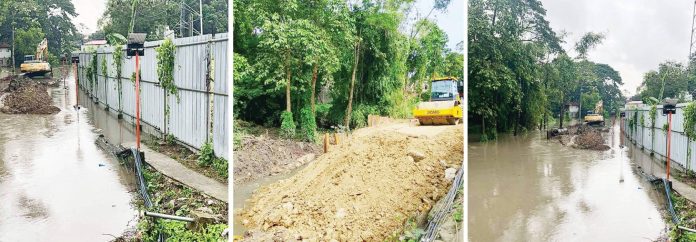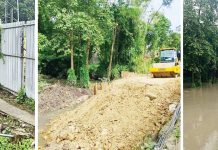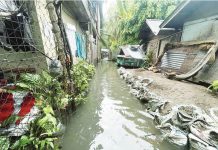
ILOILO City – Several punong barangays have renewed their outcry against Department of Public Works and Highways (DPWH) projects along waterways, blaming them for the severe flooding that inundated parts of the city last month and claiming at least two lives.
The concerns were raised during the Aug. 11 Quad Committee Joint Meeting of the Iloilo City Council, led by the Committee on Public Services, Environmental Protection, and Ecology, in response to a resolution seeking an investigation in aid of legislation into all public and private works along rivers, creeks, and waterways in the city.
Punong barangays Remedios Bedia of Lanit and Allan Jastia of Buntatala, both in Jaro district, said their areas have long served as catch basins for floodwaters from nearby Pavia town. In the past, floods rose only to knee level and quickly subsided. However, in July this year, floodwaters reached chest level and lingered.
Their own inspection revealed that ongoing DPWH bike lane and flood control projects had encroached on Buntatala Creek, narrowing its width and causing water to backflow. One of the flood-hit areas, Barangay Tagbak, also recorded the drowning of a 13-year-old in the section of the creek where the projects are ongoing.
Punong Barangay Rodney Guintibano of Calubihan, Jaro, said his barangay experienced unusually deep flooding that forced residents to evacuate and remain in shelters longer due to slow subsidence. He attributed this to the narrowing of waterways caused by the esplanade project along Desamparados Creek.
In Barangay Dungon B, Jaro, Punong Barangay Haydee Mabaga said floodwaters surged after a revetment project in nearby Barangay San Isidro rechanneled water toward their area. The number of displaced families jumped from fewer than 100 in previous incidents to 293 this year.
Punong Barangay Amadeo Sultan of Simon Ledesma, Jaro, shared similar concerns, noting a marked increase in flood depth in his barangay.
From Molo district, Punong Barangay Jose Martin Maloto of San Juan cited a drainage project that has caused seawater to backflow into homes during high tide, even without heavy rains. “Dapat ang mga contractor kag DPWH kadtuan kag i-check ang proyekto. Sa pagtan-aw ko, patumbaya lang. Ang basol ara tanan sa amon nga mga kapitan,” Maloto said.
In La Paz district, Punong Barangay Efrain Cenayo of Don Esteban slammed the DPWH’s rehabilitation of Mansaya and Budburan creeks and other drainage works, describing them as poorly planned and finalized without room for local input.
“Wala ga silinanto ang projects. Tapos i-presentar lang sa amon, final na. Indi na pwede lubagon kay ato aprobado na sa babaw,” said Cenayo.
Flooding also hit Mohon, Arevalo district, due to the narrowed waterways at the mouth of the Iloilo River from DPWH’s slope protection, bike lane, and access road projects causing floodwaters to spread into nearby Oton town in Iloilo province.
Oton’s Mayor Sofronio Fusin said the project’s obstruction of natural waterways contributed to widespread flooding in both Oton and Iloilo City.
“Waterways and creeks should serve as catch basins and be protected from unnatural intervention, obstruction, or non-essential construction. Urgent measures are needed to prevent further loss of lives, properties, and livelihoods,” Fusin stressed.
The flooding in Oton also claimed one life.
“If we look at the allegations of the complainant barangay captains and officials, there is a clear before-and-after scenario. Before, flooding was manageable; after 2025, it became much worse. I think it’s consistent to say there’s an anomaly here compared to previous incidents,” said Councilor Rex Marcus Sarabia.
Councilor Romel Duron, chairman of the Committee on Public Services, Environmental Protection, and Ecology, slammed DPWH-Iloilo City District Engineering Office (ICDEO) for snubbing the hearing and questioning the authority of the council in conducting it.
“Imagine questioning the authority of the City Council? We have broad power to protect the public especially in the city… Ang aton iya nga role indi ni ya pulitika ini pirmi kundi trabaho kon naintindihan ni Engr. Roy Pacanan. Daw edukado man ni sya. Dapat kon waay sya nagpadala sya sang iya representative,” said Duron.
BASELESS CLAIMS OF ‘POLITICAL DEMOLITION’
Mayor Raisa S. Treñas, on her part, has hit back at the ICDEO for labeling the City Council’s investigation into flood control projects as “political demolition.”
The probe was initiated following President Ferdinand “Bongbong” Marcos Jr.’s State of the Nation Address (SONA), where he called for an investigation into flood control projects in the city.
In a statement, Mayor Treñas defended the City Council’s decision to hold a committee hearing, citing the legislative body’s mandate to uphold the general welfare of the people, including protecting property and ensuring public safety.
“The committee hearing is an important venue for our legislative body to gather facts, so they can craft ordinances or local laws that directly address the urgent needs of our constituents,” she said.
Mayor Treñas emphasized that the City Council’s agenda is centered on transparency, accountability, and serving the people of Iloilo City, dismissing claims of “political demolition” as baseless.
“Wala kita sang iban nga agenda kundi transparency, accountability, kag pagserbisyo sa pumuluyo sang Iloilo City,” she stressed.
CITY COUNCIL RESOLUTION
The quad-com meeting stemmed from City Council’s Resolution No. 2025-735, signed by Vice Mayor Lady Julie Grace Baronda, wherein local legislators have scrutinized all public and private works along waterways amid mounting evidence that encroachments, narrowed channels, and obstructed drainage have worsened flooding in multiple districts.
The probe follows the July storm’s devastation: 36 barangays submerged, over 11,000 residents affected, and two confirmed deaths, including one in Oton town. In some Jaro barangays, floodwaters rose to chest level despite only moderate rainfall — submerging homes, stalling livelihoods, and forcing mass evacuations.
The barangay leaders particularly from affected barangays in Jaro pointing to DPWH’s slope protection and bike lane project at Buntatala Creek as the prime culprit was confirmed by the Iloilo City Task Force.
Other barangays reported similar issues linked to DPWH flood control, drainage, and esplanade works, as well as unregulated private construction along water easements — projects that residents claim were “poorly planned” and “improperly executed.”
“This is no longer just seasonal flooding — it’s a structural risk,” the resolution reads, warning that ongoing urbanization without proper environmental safeguards is putting lives and property at greater danger.
The Council’s inquiry, with another scheduled on Aug. 28, will assess whether these projects violated the Philippine Water Code (P.D. 1067), environmental laws, and zoning regulations. The findings could lead to stricter measures, penalties for violators, and possible redesign or removal of obstructive structures.
“This is a call for action that cannot be ignored, for the cost of inaction will always be borne by the most vulnerable,” the resolution warns, pressing the city government to act decisively to protect both the people and the city’s natural drainage systems./PN






